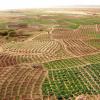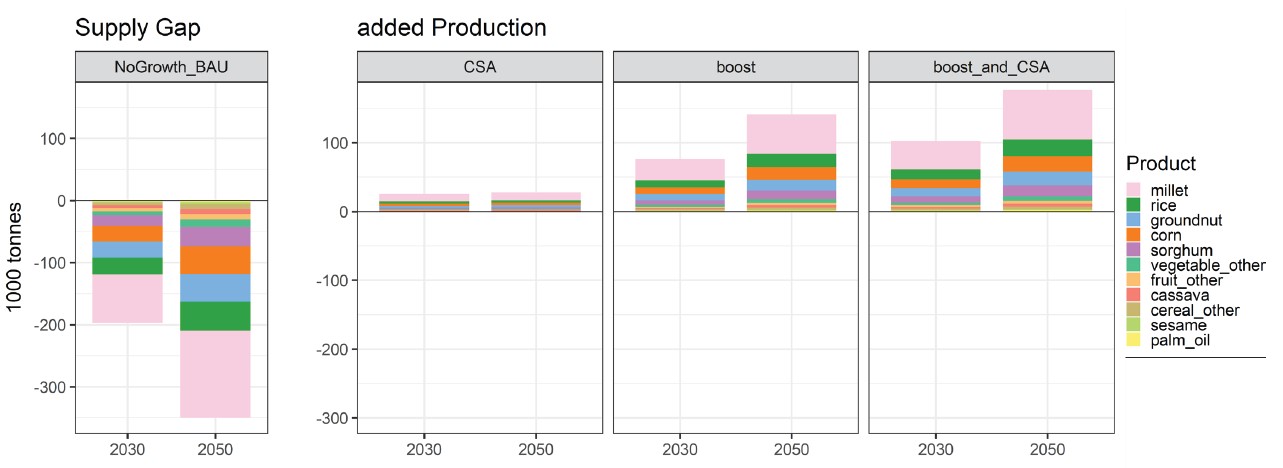
Policy Brief #36, January 2023. Co-developing resilient food and land-use systems can help bridge the gap between demand for sustainable, healthy food and attainable food supply in The Gambia.
The agricultural sector of The Gambia is predominantly rain-fed and vulnerable to climate impacts, significantly exposing the rural poor who heavily depend on it for their livelihoods to lagging productivity, food insecurity, poverty, malnutrition, and its health-related effects.
The FACE-Africa project looked into these issues and co-developed scenarios relevant to The Gambia’s food security and sustainable land-use pathways with local and international stakeholders. The project team’s recommendations for ensuring sustainable food systems in the country include the following:
- Achieving nutritional security is possible through policies that promote healthy and sustainable diets, such as the EAT-Lancet diet and the forthcoming Gambia-specific Food-Based Dietary Guidelines. Still, it requires a significant increase in either domestic agricultural production through improved yields, expanding agricultural land, or imports.
- Policies that enable farmers to access and utilize fertilizer, reduce water stress, and adopt climate-smart agricultural practices will significantly improve crop yields and local production in The Gambia.
- Investing in sustainable agricultural development through climate-smart and productivity-enhancing technologies will increase resilient agricultural production and reduce import dependency, while ensuring sustainable and healthy diets in The Gambia.
The challenge ahead
The Gambia is predominantly an agriculture-based economy. The agriculture sector continues to face tremendous challenges, threatening the livelihoods of those dependent on the sector, who continue to experience poverty, malnutrition, and related health issues. Crop production is extensively subsistence-based and rain-fed, with persistently declining productivity among major staple crops such as rice, maize, groundnut, and millet.
The sector has faced increasing and frequent adverse climatic events in recent decades, hampering agricultural productivity in The Gambia with increasing yield gaps compared to other countries in West Africa. Another major challenge to The Gambia’s food and nutritional security is its dependency on food imports, which exposes the country’s food system to external shocks. For example, over 80% of rice, a major staple food in The Gambia, is imported. Hence climatic and socioeconomic shocks in the exporting countries will have severe consequences for The Gambia’s food supply.
Co-designing future food security pathways
In June 2022, IIASA, project partners, and 25 stakeholders from several ministries, departments, farmer groups, and agencies, including the Food and Agriculture Organization of the United Nations (FAO)-Gambia; Ministries of Agriculture, Health, and Climate Change; The Gambia Bureau of Statistics (GBoS); and others, co-developed scenarios relevant to the country’s food security and sustainable land-use pathways.
The work was done as part of the FACE-Africa project, which aimed to work closely with government policymakers and food system stakeholders, including farmers, retailers, and consumers, to jointly generate evidence to inform climate change adaptation strategies in food systems. The scenarios developed as part of the project focused on sustainable diet options, climate change impacts, agricultural productivity, agricultural trade flows, land use, and national climate, as well as nutritional and agricultural policies. Furthermore, input data required for modeling was improved, and the potential of climate-smart agriculture to increase future yields using published field studies was investigated.
Key findings and policy recommendations
Shifting towards sustainable diets is attainable but with significant implications for land use and import dependency
Whether sustainable and healthy diets are achievable in The Gambia has important policy implications.
Comparing a healthy, sustainable diet to a “business as usual” diet, researchers found that sustainable diets, which include a reduction in the consumption of oils and fats, and an increase in the consumption of fruits, vegetables, and pulses, are possible. However, this requires an increase in production, shifting the focus of local production from cereals to fruits and vegetables, pulses, and livestock products. It would also require extensive deforestation and land conversion to cropland and pastures in the absence of increased productivity, which puts an enormous burden on biodiversity.
Additionally, a shift in the composition of food imports from cereals towards fruits and vegetables is necessary, confirming observations made by the stakeholders that increased consumption of fruits and vegetables among the Gambian population can be achieved through regional imports from neighboring nations that form part of the Economic Community of West African States (ECOWAS) versus local production. This supports the conclusion that proportions of The Gambia’s food supply are produced in countries similarly vulnerable to climate change, which also has severe implications for food availability, affordability, and consumption, intensifying nutritional challenges. Therefore, enhancing food supply resilience should be the priority.
In the absence of adaptation and resilience options, adverse climate conditions will continue to widen yield gaps, exacerbate crop losses, and increase dependency on imports, further threatening the food security of The Gambia.
In The Gambia, the adverse impacts of climate change are likely to reduce the yields of major staple crops such as cereals, oilseeds, roots and tubers, and pulses.
Although significant land use conversion (i.e., from forest into cropland and pasture) has not been observed, the crop-specific area harvested varies considerably under climate change. As a result, there is a shift in production away from cash crops (i.e., groundnut and palm fruit) to staple crops (i.e., rice, corn, millet, and sorghum).
Without adopting climate resilience options, adverse climate conditions will continue to decrease yields and reduce production, widening the gap in food supply (Figure 1). Consequently, imports will be needed to fill the gap between sufficient production to meet growing demand and feasible production under low productivity growth and climate effects, thus decreasing The Gambia’s food self-sufficiency and increasing its dependency.
Reducing nutrient and water stress increases agricultural productivity and improves food availability
Improving nutrition, diets, and access to food is one of the core aims of the Gambian government, especially in rural communities that are heavily dependent on agriculture. With no change to crop management practices, crop yields will remain low and decrease over time, posing a major threat. However, increasing access to fertilizer and water for irrigation could increase rice production sevenfold, with a resulting 30% decrease in imports. Corn, millet, and groundnut production under these conditions increases approximately twofold. The feasible supply of major cereals necessary for The Gambia’s food supply grows considerably.
Investing in sustainable agricultural development through climate-smart and productivity-enhancing technologies will increase production and reduce import dependency while ensuring sustainable and healthy diets in The Gambia
Investing in climate-resilient, productivity-enhancing, and cost-reducing farming strategies and technologies (i.e., minimum soil disturbance, fertilizers, crop protection, irrigation, and drought-tolerant varieties) has significant implications for sustainable and healthy diets in The Gambia. Enhancing agricultural productivity and improving farmers’ resilience to climate change effects greatly increases crop production. Major cereal yields (i.e., rice, corn, millet, and sorghum), pulses (i.e., groundnut), and tubers (i.e., cassava) increase more than twofold.
Specifically, rice yields will increase from an average of 0.5t/ha to 4t/ha by 2050. The cropland area could diversify, with a decrease in crop area under cereal production and an increase in pulses, fruit, and vegetable area. Although imports are still necessary for The Gambia’s food supply, its import dependency for major crops decreases, and exports of pulses (i.e., groundnut) increase.
 © IIASA
© IIASA
Figure 1. Supply gap under business-as-usual (BAU) and production added under climate-smart agriculture adoption (CSA), enhanced productivity (boost) and combined CSA and enhanced productivity (boost & CSA).
The Food, Agriculture, Biodiversity, Land-Use, and Energy (FABLE) Calculator is a Microsoft Excel-based accounting tool developed within the framework of the FABLE consortium and The Food and Land Use Coalition. The tool examines the potential evolution of food and landuse systems over the period 2000-2050, with a focus on developments in the agriculture sector. The tool was adapted for The Gambia and used to assess the impact of multiple possible future scenarios (i.e., climate change, agricultural productivity) on key food security indicators to show the achievability of healthy and sustainable diets.
Tools for policymakers
The FACE-Africa - Shiny app visualization tool ensures that the FABLE-Gambia Calculator scenario results are accessible for technical experts, policymakers, researchers, and NGOs working in the food, agriculture, land use, trade, and economics sectors in The Gambia.
About this research and the FACE-Africa project
The FACE-Africa project is led by the London School of Hygiene & Tropical Medicine (LSHTM) and the Medical Research Council (MRC) Unit in The Gambia, with collaborators at the International Institute of Applied Systems Analysis (IIASA) in Austria, the CGIAR Research Program on Climate Change, Agriculture, and Food Security (CCAFS) in West Africa based at the International Crops Research Institute for the Semi-Arid Tropics (ICRISAT) in Mali, and the University of Cambridge. The IIASA team consisted of Felicity Addo, Amanda Palazzo, Esther Boere, and Petr Havlík.
This policy brief was written by Felicity Addo and Amanda Palazzo, with support from the IIASA team, Tony Carr from LSHTM, and Ansa Heyl.
This project is funded by Wellcome (grant number 216021/Z/19/Z). We are grateful to the stakeholders for sharing their expertise, exploring the model tools, and co-developing the scenario pathways with us during our workshop.
 © IIASA
© IIASA
References and useful resources
Ali, Z., Scheelbeek, P.F.D., Felix, J., Jallow, B., Palazzo, A. , Segnon, A.C., Havlík, P. , Prentice, A.M., & Green, R. (2022). Adherence to EAT-Lancet dietary recommendations for health and sustainability in the Gambia. Environmental Research Letters 17 (10) e104043. 10.1088/1748-9326/ac9326.
Mosnier, A., Penescu, L., Pérez Guzmán, K. , Steinhauser, J., Thomson, M. , Douzal, C., & Poncet, J. (2020). FABLE Calculator 2020 update. International Institute for Applied Systems Analysis (IIASA) and Sustainable Development Solutions Network (SDSN) , Laxenburg, Austria. 10.22022/ESM/12-2020.16934.
Carr, T. W., Mkuhlani, S., Segnon, A. C., Ali, Z., Zougmoré, R., Dangour, A. D., Green, R., & Scheelbeek, P. (2022). Climate change impacts and adaptation strategies for crops in West Africa: A systematic review. Environmental Research Letters, 17(5).
Hadida, G., Ali, Z., Kastner, T., Carr, T. W., Prentice, A. M., Green, R., & Scheelbeek, P. (2022). Changes in Climate Vulnerability and Projected Water Stress of The Gambia’s Food Supply Between 1988 and 2018: Trading With Trade-Offs. Frontiers in Public Health, 10(May), 1–13.
Segnon, A. C., Zougmoré, R. B., Green, R., Ali, Z., Carr, T. W., Houessionon, P., M’boob, S., & Scheelbeek, P. F. D. (2022). Climate change adaptation options to inform planning of agriculture and food systems in The Gambia: A systematic approach for stocktaking. Frontiers in Sustainable Food Systems, 6.



